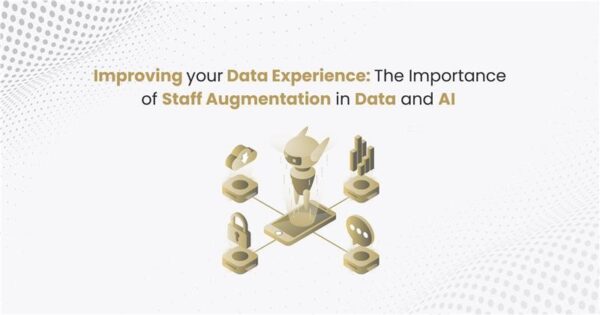In today’s world, using data and AI (Artificial Intelligence) smartly is crucial for businesses to make good decisions and work efficiently. But, because this area is growing and changing so fast, it’s hard for companies to keep up with the new skills and knowledge they need. Adding more staff from outside the company, or “staff augmentation,” becomes essential. It helps companies fill in the missing skills, handle more work, and develop new ideas faster. This blog talks about how bringing in extra staff can help a company get better at working with data and AI. It covers the good things about this approach, some advice on how to do it right, and how to implement this idea in your company.
Understanding Staff Augmentation in Data and AI
Staff augmentation is a flexible outsourcing strategy that allows companies to hire tech talent globally and manage augmented teams directly. It’s especially relevant in fields like data science and AI, where the demand for skilled professionals far exceeds the supply. By augmenting their staff, organizations can swiftly incorporate the expertise required to drive their data initiatives without the long-term commitment of hiring full-time employees.
Benefits of Staff Augmentation
Access to Specialized Talent
One of the most significant advantages is immediate access to a global specialized talent pool. Whether you need expertise in machine learning, deep learning, data engineering, or analytics, staff augmentation can promptly fill these needs.
Scalability and Flexibility
Staff augmentation allows businesses to scale their workforce up or down based on project demands, providing a flexible approach to managing workload fluctuations without the overheads associated with permanent hires.
Cost Efficiency
By hiring staff on a project basis, companies can optimize their budgets, reducing costs associated with recruitment, benefits, and other employment-related expenses.
Accelerated Project Delivery
Bringing in experts who can hit the ground running reduces project ramp-up time, facilitating faster turnaround times and improved productivity.
Choosing between Staff Augmentation vs Traditional Hiring for Data and AI Services
When companies want to add more people to their teams, they often wonder: should they hire new employees the usual way or use staff augmentation to bring in people for a short time? This choice isn’t just about adding more people; it’s about figuring out the best mix of steady workers and flexible help to match the company’s needs as it grows and changes.
Let’s examine what makes each option different and determine which one might be the best fit for your company’s needs and goals.
| Traditional Hiring | Staff Augmentation |
| Time Consuming Process Time spent on sourcing, evaluating, and interviewing |
Quick access to specialized talent No need for costly hiring procedures |
| High Cost On-going expenses like salaries, benefits, and training |
Cost-Effectiveness Just pay for the work you get, which helps save money. |
| Limited Skill Set Difficulty in finding candidates who have the specific skills required. |
Exposure to specified knowledge Accessing a large group of unique, skilled professionals |
| Fixed Commitments Long-term commitments with full-time employees |
Flexibility & Scalability Ability to adjust the number of team members as per the requirements of the project |
Engagement Models for Data and AI Services
When it comes to engaging outside experts for data and AI projects, companies have several options to consider. Each method offers its own unique advantages, tailored to fit various project sizes and company goals.
One of the most popular engagement models is the project-based approach, where companies hire external experts for specific tasks within a defined scope. This model offers clear deliverables and timelines, making it ideal for short-term projects with well-defined objectives. On the other hand, the dedicated team engagement model involves assembling a team of external experts to work exclusively on a company’s projects for an extended period. This approach ensures continuity and consistency in project execution, allowing for seamless integration with the in-house team.
Another option is the managed services engagement model, where companies outsource the entire project or specific functions to a third-party service provider. This model provides access to a broader range of expertise and resources, allowing companies to focus on their core competencies while the service provider manages the project. Additionally, the consulting engagement model involves hiring consultants or advisory firms to provide strategic guidance and expertise in data and AI initiatives. This model offers access to industry best practices and insights, enabling organizations to stay ahead of emerging trends and technologies.
Each engagement model has its own set of advantages, and the choice depends on factors such as project complexity, timeline, budget, and internal capabilities. By understanding the different options available, companies can make informed decisions that align with their strategic objectives and maximize the success of their data and AI initiatives.
Conclusion:
In conclusion, selecting the right engagement model is crucial for the success of data and AI projects within organizations. Whether through project-based arrangements, dedicated teams, managed services, or consulting engagements, companies have a variety of options to choose from based on their specific requirements and objectives.
Staff augmentation emerges as a flexible solution, allowing companies to tap into a global talent pool and access specialized expertise on-demand. By leveraging external resources effectively, organizations can overcome skill shortages, accelerate project delivery, and drive innovation without the long-term commitments associated with traditional hiring.
Moreover, successful implementation of staff augmentation relies on careful planning, clear communication, and strategic alignment with business goals. By adopting the right engagement model and leveraging external expertise, companies can unlock the full potential of data and AI to drive growth, innovation, and competitive advantage in the digital age.



